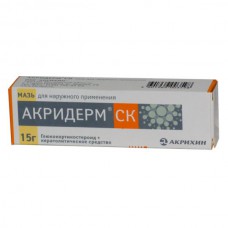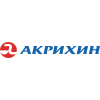Expiration date: 10/2026
The composition and form of issue:
Akriderm
Cream 1 g contains:
betamethasone dipropionate 0.64 mg
excipients: nipagin a solid paraffin petrolatum propylene glycol, vaseline oil, medical cetostearyl alcohol emulsifying type or emulsifying wax type "Lanette SX" disodium salt of ethylenediaminetetraacetic acid (Trilon B) sodium sulfite 7-water purified water
in tubes of 15 or 30 grams in a cardboard bundle 1 tuba.
Akriderm of GENTA
Cream for external use 1 g contains:
betamethasone dipropionate 0.64 mg
gentamicin sulfate 1 mg
excipients: nipagin propylene glycol mineral oil air macrogol 20 cetostearyl cetostearyl alcohol disodium ethylendiaminetetraacetic sodium phosphate disodium phosphate potassium odnosemjannyj purified water
in tubes of 15 or 30 grams in a cardboard bundle 1 tuba.
Akriderm GK
Cream for external use 1 g contains:
betamethasone dipropionate 0.64 mg
clotrimazole 10 mg
gentamicin sulfate 1 mg
excipients: propylene glycol vaseline vaseline oil rubbing alcohol cetostearyl ether cetostearyl macrogol Trilon B sodium dihydrogen phosphate dihydrate (sodium phosphoric acid odnosemjannyj 2-water) purified water
in tubes of 15 or 30 grams in a cardboard bundle 1 tuba.
Akriderm SK
Ointment for topical application 1 g contains:
betamethasone dipropionate 0.64 mg
(equivalent to 0.5 mg betamethasone)
salicylic acid 30 mg
excipients: vaseline, vaseline oil
in tubes of 15 g or 30 g in a cardboard bundle 1 tuba.
Description pharmaceutical form:
Cream — white, or almost white.
Ointment from white to white with a yellowish or kremovatam white color. Allowed the presence of a weak peculiar smell.
Feature:
Akriderm
The glucocorticosteroid for local use.
Akriderm of GENTA
Combined preparation for external use (glucocorticosteroid + antibiotic-aminoglycoside).
Akriderm GK
Combined preparation for external use (glucocorticosteroid + antibiotic-aminoglycoside + anti-fungal agent).
Akriderm SK
Combined preparation for external use (glucocorticosteroid + keratolytic agent).
Pharmacological action:
Akriderm
Protivovospalitelnoe, antiallergic, antiexudative, antiedemic, antipruritic
Akriderm of GENTA
Anti-inflammatory, antiallergic, antibacterial
Akriderm GK
Anti-inflammatory, antiallergic, antibacterial, antifungal
Akriderm SK
Anti-inflammatory, anti-allergic, antiseptic, keratolytic
Description pharmacological action:
Corticosteroid betamethasone dipropionate inhibits the accumulation of leukocytes, release of lysosomal enzymes and proinflammatory mediators in inflammation, inhibits phagocytosis, reduces vascular tissue permeability, prevents the formation of inflammatory edema.
Gentamicin is a broad-spectrum antibiotic of the aminoglycoside. It has bactericidal activity against pathogens of primary and secondary bacterial skin infections. Active against gram-negative bacteria: Pseudomonas aeruginosa, Aerobacter aerogenes, Escherichia coli, Proteus vulgaris, Klebsiella pneumoniae gram-positive bacteria: Streptococcus spp. (sensitive strains of beta - and alpha-hemolytic Streptococcus group A), Staphytococcus spp. (coagulasepositive, coagulasepositive and some strains producing penicillinase). Inactive against anaerobes, fungi and viruses.
Clotrimazole has antifungal activity by disrupting synthesis of ergosterol, which is an integral part of the cell membrane of fungi. Active against: Trichophyton rubrum, Trichophyton mentagrophytes, Epidermophyton floccosum, Microsporum canis, Candida albicans, Malassezia furtur (Pityrosporum orbiculare).
Salicylic acid provides keratolytic, antimicrobial effect, reduces the Horny layers and promotes deeper penetration of the corticosteroids.
Indications:
Akriderm
Allergic skin disease (including acute, subacute and chronic contact dermatitis, professional dermatitis, seborrheic dermatitis, atopic dermatitis, solar dermatitis, atopic dermatitis, itching, skin dermatitis, eczema) acute and chronic non-allergic dermatitis psoriasis.
Akriderm of GENTA
Dermatitis (simple and allergic), particularly secondarily infected, (atopica, children's, nummular), atopic dermatitis (diffuse neurodermatitis), simple chronic zoster (limited neurodermatitis), solar dermatitis, exfoliative dermatitis, radiation dermatitis, diaper rash, psoriasis, itching.
Akriderm GK
Treatment of dermatosis, complicated by primary and/or secondary infection, pityriasis versicolor, limited and diffuse neurodermatitis, ringworm (including groin, foot), caused by sensitive to the drug pathogens.
Akriderm SK
Local treatment of dermatoses accompanied by hyperkeratosis: psoriasis, limited and diffuse neurodermatitis, lichen planus, eczema, skin dermatitis, ichthyosis and ihtiosiformnye changes.
Contraindications:
Hypersensitivity to any component of the drug, tuberculosis skin, skin manifestations of syphilis, varicella, herpes simplex, post-vaccination skin reactions, open wounds, lactation and children up to age 1 year in addition to drug Akriderm: leg sores, rosacea, acne vulgaris additionally for drug of Akriderm GK: in the treatment of external otitis media — perforation of the tympanic membrane for further drug Akriderm SK: perioral dermatitis.
Application of pregnancy and breast-feeding:
The safety of topical corticosteroids in pregnant women not established prescribing of this group of drugs in pregnancy is justified only if the potential benefit outweighs the potential risk. During pregnancy this group of drugs should not be used in high doses or for a long time.
Unclear whether topical application of corticosteroids cause their appearance in mother's milk, therefore it is necessary to solve the issue of termination of breastfeeding.
Side effects:
The local application of corticosteroids may occur: burning, irritation, dryness, folliculitis, hypertrichosis, acne-like rash, hypopigmentation, perioral dermatitis, allergic contact dermatitis. With prolonged use, and the use of occlusive dressings — maceration of skin, secondary infection, skin atrophy, miliaria, purpura.
Akriderm
When applied to a large surface of the body, mainly in children you may experience systemic side effects of corticosteroids (hyperglycemia, glucosuria, reversible inhibition of the function of the adrenal cortex, manifestation of Cushing's syndrome).
Akriderm of GENTA
Akriderm GK
When applied to a large surface of the body, mainly in children you may experience systemic side effects of corticosteroids (hyperglycemia, glucosuria, reversible inhibition of the function of the adrenal cortex, manifestation of Cushing's syndrome) and gentamicin (nephrotoxic and ototoxic effects).
Akriderm SK
When applied to a large surface of the body, mainly in children may cause systemic side effects corticosteroids and salicylates.
When adverse reactions, not described in the instructions, you should consult a doctor.
Drug interactions:
Drug interactions with other drugs is not revealed.
Method of application and dose:
Akriderm
Akriderm of GENTA
Akriderm GK
Externally. Apply a thin layer to the affected skin area 2 times a day — morning and evening. Other frequency of application may be established by a physician based on the severity of the disease. In mild cases cream is sufficient to apply, as a rule, 1 time per day in more severe lesions may need more frequent application.
Duration of treatment depends on the efficacy and tolerability of therapy is 2-4 weeks.
If clinical improvement does not occur, it is necessary to clarify the diagnosis.
Akriderm SK
Externally. Apply a thin layer to the affected skin area 2 times a day — morning and evening. Other frequency of application may be established by a physician based on the severity of the disease. In mild cases ointment is sufficient to apply, as a rule, 1 time per day in more severe lesions may need more frequent application.
Overdose:
Acute overdose is unlikely, however, excessive or prolonged use of drugs possible chronic overdose accompanied by signs of hyperadrenocorticism: hyperglycemia, glucosuria, reversible inhibition of the function of the adrenal cortex, manifestation of Cushing's syndrome.
Treatment: symptomatic therapy. In the case of chronic toxic effect the gradual elimination of the drug.
Special instructions:
If there are signs of hypersensitivity or skin irritation associated with the use of drugs, should stop treatment and choose the patient adequate therapy.
With prolonged treatment, when applied to the drugs on a large surface of the skin, with the use of occlusive dressings, as well as in children, possible systemic absorption of corticosteroids.
Children 1 year of age the drug is prescribed only under strict indications and under medical supervision, because the evolution of systemic side effects associated with betamethasone. In applying the drug in large surfaces and/or under occlusive dressing may suppress the function of the hypothalamic-pituitary-adrenal system and development of symptoms gipercortitizma, there may be decrease excretion of growth hormone, increased intracranial pressure.
On the face often than other surfaces of the body, after prolonged treatment with glucocorticoids, local actions may occur atrophic changes in the course of treatment in this case should not exceed 5 days.
Cream and ointment is not intended for use in ophthalmology. To avoid preparation hit in eyes.
Prolonged use of the drug, its abolition should be gradual.



